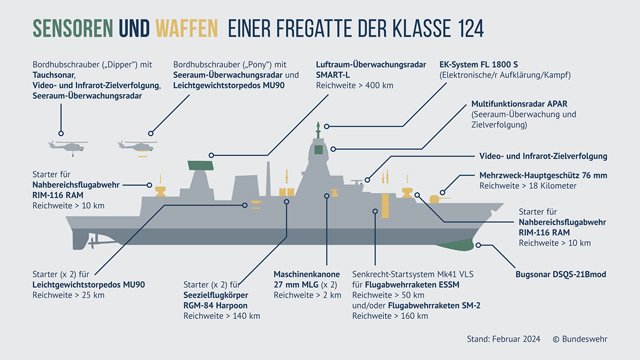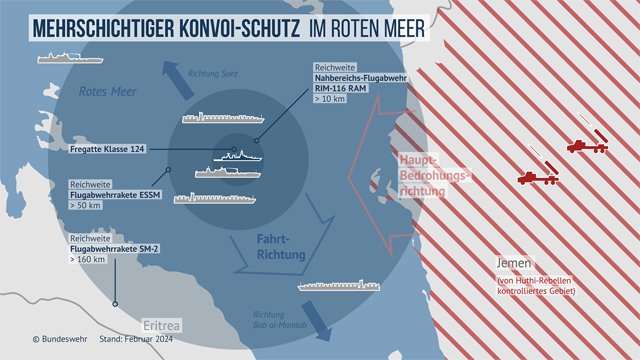Houthi rockets threaten the Red Sea. The technology and tactics of the frigate “Hessen” and its crew are specialized precisely for this danger.
Warships from several nations repel most Houthi attacks on international shipping in the Red Sea. The US Navy began Operation Prosperity Guardian in the region in December 2023, supported by some allies. The mission emerged from the naval group Combined Task Force 153 , which is already on site and has been monitoring maritime security in the Red Sea and Gulf of Aden since 2022. The European Union has organized its own naval operation in the same area, in which the German Navy is initially participating with one of its air defense frigates: the F124 class frigate “Hessen” .
The basis for these operations is, above all, a decision by the UN Security Council of January 10, 2024. It calls on the Houthis to immediately stop all attacks. They hindered global trade and navigation freedoms and undermined peace and security in the region.

The German federal government has joined this. After an attack with around 20 drones and missiles on January 9th, the Foreign Office spokesman said at the government press conference the following day: “We strongly condemn the Houthi attack on international ships in the southern Red Sea last night.” That was was the most extensive Houthi attack on international shipping since mid-October. The ongoing attacks showed “that the Houthis are clearly committed to escalation against international merchant shipping and against the ships of our partners and allies in the region.”
Meanwhile, shipping companies around the world have begun to redirect their sea transport. Ships from the Danish company Maersk, for example, now avoid the region, as do those from the German Hapag-Lloyd. Instead of traveling through the Suez Canal and the Red Sea on the way between Europe and Asia, they have to take the detour around the Cape of Good Hope. The route south around Africa means a journey for merchant ships that takes up to two weeks longer than usual. This has a significant impact on transport costs and supply chains, especially in Europe.
International warships, frigates and destroyers that are supposed to protect commercial traffic in the region are basically similarly equipped. A German Class 124 frigate can detect threats in the air at long ranges with its main radar SMART-L. The SMART-L has a range of around 400 kilometers, but can detect targets better over sea than over land. Due to the mountainous region of western Yemen, this radar can only detect low-level objects from approximately the coastline.
If the ship moves and a convoy of merchant ships that needs to be protected, for example from the north towards the Bab al-Mandab strait, which is only 28 kilometers wide, it essentially drives into a funnel. The increasingly narrow sea area means shorter warning times. The crew of the frigate must therefore be well trained in order to be able to react quickly. However, it can receive support from maritime patrol aircraft or reconnaissance satellites, whose sensors can see the mainland better from a much higher position. The prerequisite is that the frigate is integrated into a smoothly functioning network for data exchange. NATO ships practice the procedures for this regularly and intensively.
A Type 124 frigate then uses the target tracking mode of its multi-purpose radar APAR to defend itself against attackers from the air. This supports live fire with the ship’s anti-aircraft guided missiles. The APAR guides its own rockets to the target.
In this way, the frigate covers an area of more than 1,000 square kilometers with its SM-2 anti-aircraft missiles. With their missiles of the next shorter range, the ESSM (Evolved Sea Sparrow Missile), it still covers over 300 square kilometers. Within this zone, a convoy of ships finds double protection against attacks from the air.
A third perimeter by the RAM (Rolling Airframe Missile) still covers a good 60 square kilometers. Especially with this weapon system, the frigate serves as a sort of libero: Thanks to its powerful drive, it can quickly change its position in relation to a convoy in order to counter the current greatest threat.
Defending enemy guided missiles is the core task of a so-called “ major air defender”, a NATO term like the German “Hesse”. The capability is essentially no different than what would be required of the warship in a conventional military conflict.
The crew of the air defense frigate trains the procedures regularly and intensively. Most of the crew are familiar with the live fire of their own anti-aircraft weapons from the Navy’s annual Missile Firing Exercises . The participating ships combat approaching target display drones. If successful, the simulated attackers will be destroyed.

